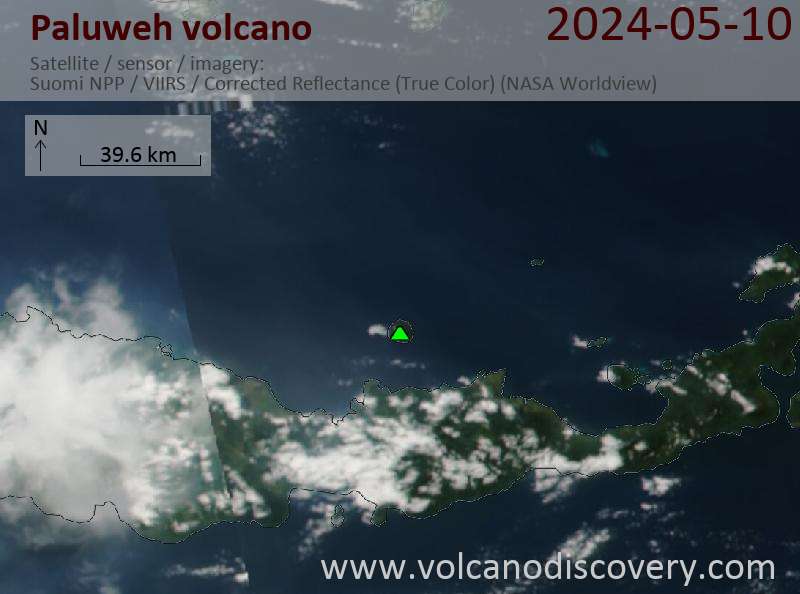Paluweh Volcano
Paluweh volcano (also known as Rokatenda), is the tip of a large, mostly submerged stratovolcano rising 3000 m from the sea floor. It forms a small 8 km wide island with the same name north of Flores Island. Paluweh has a complex summit composed of several overlapping craters and lava domes up to 900 m wide.
Several flank vents were formed by flank eruptions on a NW-trending fissure. The largest historical eruption of Paluweh in 1928 was highly explosive and produced a landslide triggering a tsumani.
Paluweh volcano eruptions: 2012-13, 1984-85(?), 1980-81, 1973, 1972-73, 1963-66, 1928, 1650
Latest nearby earthquakes
| Date and Time | Mag / Depth | Distance / Location | |||
|---|---|---|---|---|---|
Paluweh Volcano Photos




Significant volcanic eruptions: Paluweh volcano
There is one uncertain or discredited eruption in 1831 from Paluweh volcano.
| Date | Note | VEI | Deaths | Damage | |
|---|---|---|---|---|---|
| Rokatenda Historical obs./docs. | 3 | ||||
| 2013 Aug 10 (eruptive episode | Historical obs./docs. | 3 | 5 | Info | |
| 2013 Feb (eruptive episode | Historical obs./docs. | 0 | light | Info | |
| Rokatenda (west side of lava dome) Historical obs./docs. | 1 | ||||
| Rokatenda (west side of lava dome) Historical obs./docs. | 2 | ||||
| Rokatenda Historical obs./docs. | 2 | ||||
| 1981 Sep 5 (eruption | Historical obs./docs. | 2 | light | Info | |
Historical obs./docs. | 2 | ||||
| Rokatenda Historical obs./docs. | 3 | ||||
| 1973 Jan (eruption | Historical obs./docs. | 3 | light | Info | |
| Rokatenda (1928 crater) Historical obs./docs. | 2 | ||||
| 1964 Jan 1 (eruption | Historical obs./docs. | 2 | 1 | Info | |
| Rokatenda Historical obs./docs. | 3 | ||||
| 1928 Aug 4 (eruption | Tsunami recorded Historical obs./docs. | 3 | 226 | moderate | Info |
?? | Uncertain Eruption | ? | |||
Historical obs./docs. | 3 | ||||
Eruptions of Paluweh volcano
Reports suggesting activity in 1984-85 have been discredited.
New activity began in November 1980 and continued intermittently to the end of January 1981. A new 40 m wide vent formed in early November on the upper NNE flank. On 9 November, an eruption column rose 1 km from the summit crater. Bombs fell nearby and 2 mm of ash were deposited 1 km to the W. On 18 January, a "hot air wave" was felt by the inhabitants of two E-flank villages. About 1,850 persons were evacuated from the danger zone. On 27 January ejecta set bushes afire near a flank village. Detonations from explosions on 31 January were heard at Kota Baru, Flores Island.
Activity decreased from February on.
By July, the lava dome was 200 m high, its volume exceeded 8.5 x 10E6 m3, and its summit had become the highest point on the volcano at 875 m above sea level. Activity increased again in August. Strombolian activity was observed on 22 August. On 24 August ocean water temperatures around the island were measured as high as 98°C. No casualties were reported, but inhabitants evacuated the area. Crops and fishing boats were damaged.
Explosive activity resumed on 5 September producing a 1-km-high plume. This activity was followed by the destruction of the lava dome. Pyroclastic flows damaged 36 buildings in a village, including a church and five shelters, but caused no fatalities, because the people had been evacuated.
After the destruction of the lava dome, activity probably ceased, as there are no more reports available.
---
Source: GVP monthly reports
After residents evacuated, pyroclastic flows burnt 36 buildings.
Paluweh erupted in January 1973, ejecting ash and bombs to 100 m above the crater. Large amounts of vegetation were destroyed.
Explosive activity between 1963 and 1966 produced pyroclastic flows, lava flows and a lava dome. Fatalities were caused by pyroclastic flows.
On 4 August 1928, a large explosive eruption caused a landslide, which in turn triggered a tsunami with waves up to 5-10 m height, killing more than 160 people.
Paluweh Volcano FAQ
+When was the last eruption of Paluweh volcano?
The last confirmed eruption of Paluweh occurred during 2012 - 2013.
+How often does Paluweh volcano erupt?
Since 1650 AD, Paluweh volcano has had at least 9 historically documented eruptions. This means that it erupts on average every 42 years.
Many eruptions of Paluweh have lasted more than one year. In total, the volcano has been in eruption during 14 out of 375 years until now. In other words, Paluweh has been active at least one in 26.8 years on average. Note that this value is likely an underestimate, because the known history of eruptions from Paluweh is likely incomplete, especially further back in time.
+How active is Paluweh volcano at present?
Paluweh volcano is relatively active: Since 1900, it has had 13 eruptions, and been active during 13 years out of 126 as of now. This means, Paluweh has been in eruption one in 9.7 years on average. The last eruption was from 2012 until 2013 and ended 12 years ago.
+When was the largest eruption of Paluweh volcano?
The largest eruption of Paluweh volcano in historic times occurred during 2012 - 2013. It ranks as a "vulcanian" eruption with a magnitude 3 on the VEI (Volcanic Explosivity Index) scale.
Latest satellite images
Paluweh Volcano Maps





































